Birds are known for their beautiful and vibrant colors, and pink is one of the most enchanting hues that adorn their feathers. Pink coloration in birds is not just a whimsical trait; it serves a vital purpose in their lives. Ranging from attracting mates to blending into their surroundings, these rosy hues make these birds both captivating and highly adaptable.
In this article, we will explore some of the most elegant types of pink birds found around the world. From the iconic American Flamingo to the shy Pink-Headed Fruit Dove, we will discover their unique features, habitats, and behaviors.
You are reading: 12 Elegant Types Of Pink Birds
So, let’s dive into the realm of these feathered wonders and learn about their fascinating world.
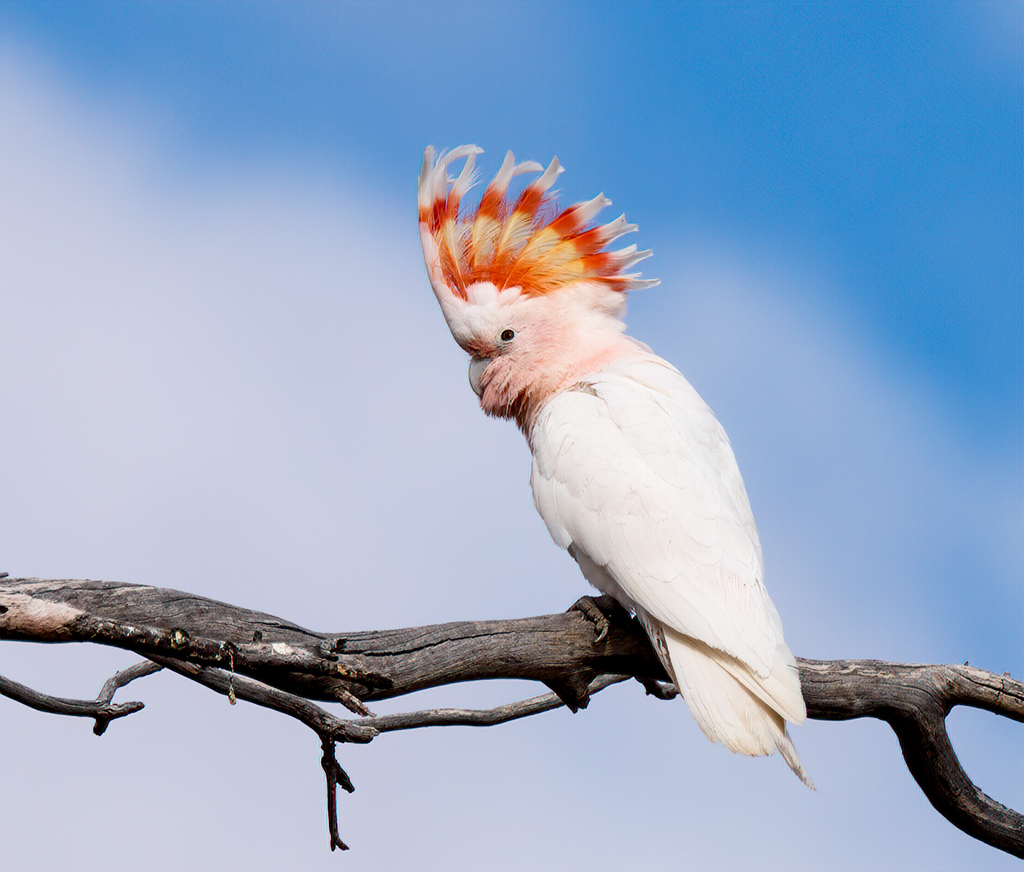
12 Elegant Types Of Pink Birds
American Flamingo
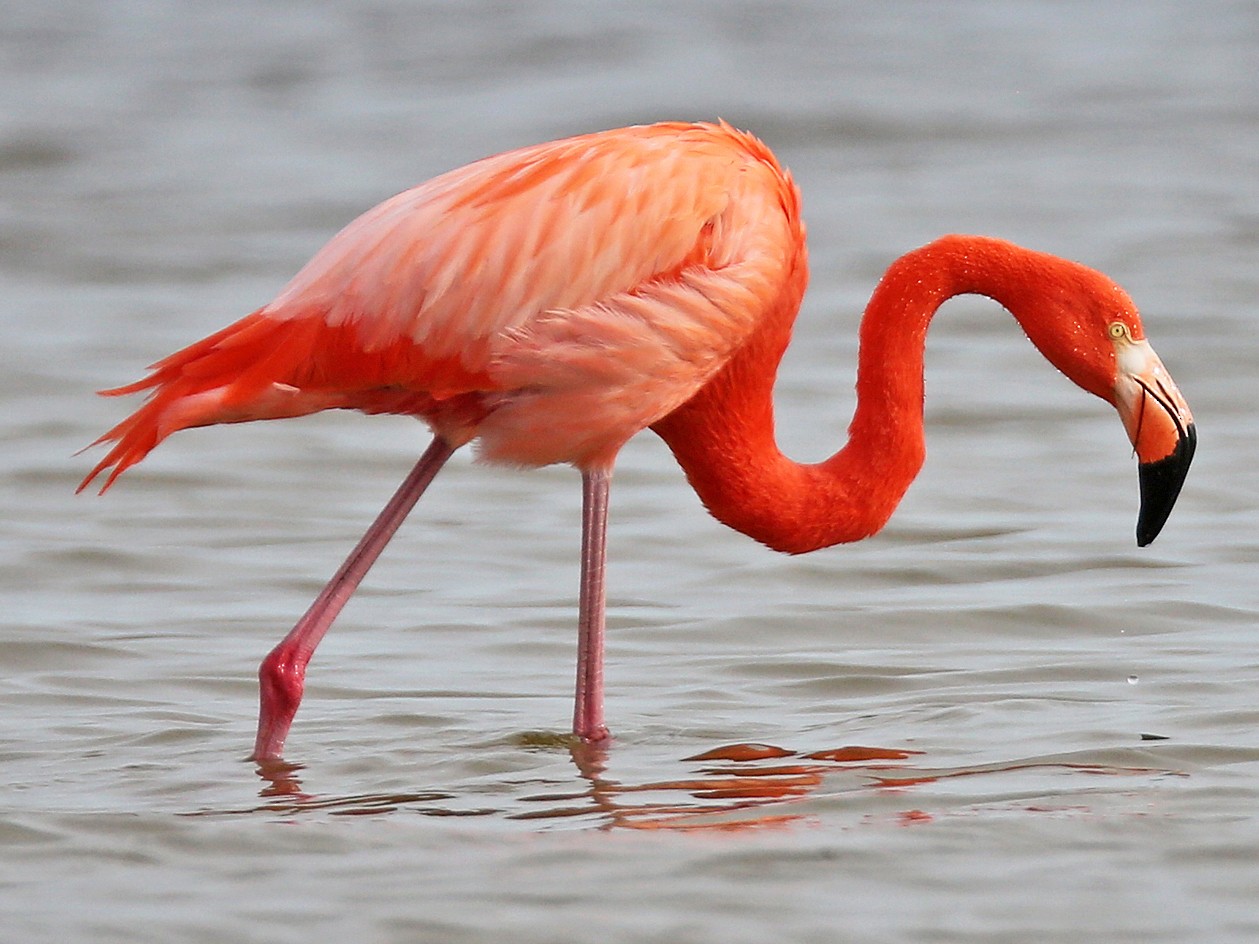
The American flamingo (Phoenicopterus ruber) is a large and elegant species of flamingo that is native to the West Indies, northern South America, and the Yucatan Peninsula. It is closely related to the greater flamingo and Chilean flamingo, and it is the only flamingo that naturally inhabits North America.
The American flamingo is one of the largest species of flamingo, with an average adult height of 5 feet (1.5 meters) and weight of 4-8 pounds (1.8-3.6 kilograms) . Its plumage is a distinctive pink color with black flight feathers along the edges of the wings, and it has a slender body, very long legs, a long, flexible neck, and a small head.
The flamingo’s bill has a characteristic downward bend, and its feet are relatively small, with the front three toes webbed and the back toe either tiny or missing altogether.
American flamingos are social birds that often congregate in large flocks, and they communicate through a variety of vocalizations and body displays.
Scarlet Ibis
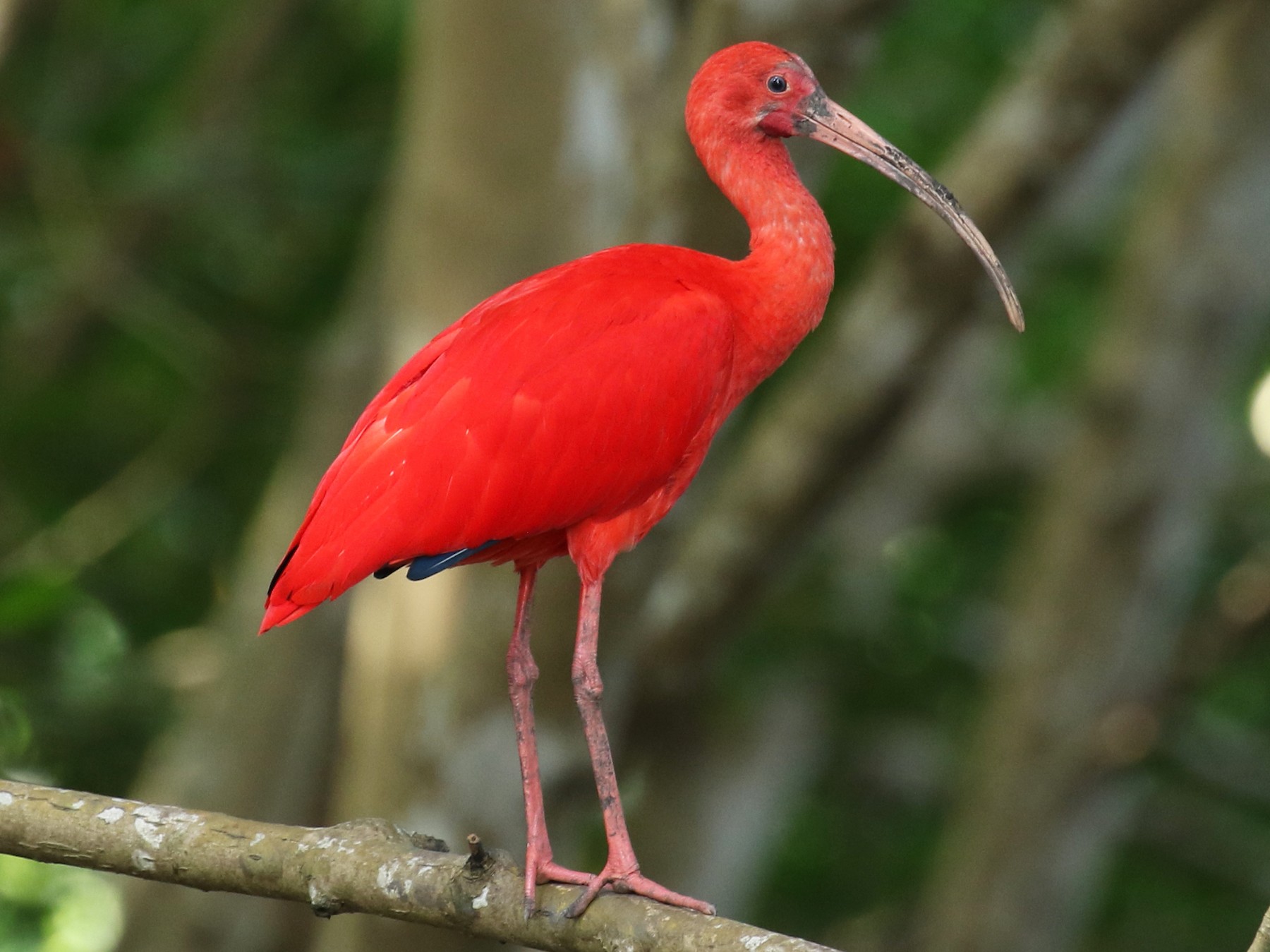
The Scarlet Ibis (Eudocimus ruber) is a medium-sized wading bird that inhabits tropical South America and part of the Caribbean. It is known for its striking and vibrant red plumage, which makes it easily recognizable.
The Scarlet Ibis is one of the two national birds of Trinidad and Tobago, and its Tupi–Guarani name, guará, is part of the name of several municipalities along the coast of Brazil.
The Scarlet Ibis is closely related to the American white ibis (Eudocimus albus), and the two birds have exactly the same bones, claws, beaks, feather arrangements, and other features, with their one marked difference lying in their pigmentation.
Scarlet Ibis are sociable and gregarious birds that live in flocks of thirty or more, and they are very communally-minded regarding the search for food and the protection of the young.
Pink-Headed Fruit Dove

Read more : Do Parakeets Sleep With Their Eyes Open
The Pink-Headed Fruit Dove (Ptilinopus porphyreus) is a small, colorful dove that is also known as the Pink-Necked Fruit Dove or Temminck’s Fruit Pigeon. Here are some interesting facts about this bird:
Appearance:
– The male Pink-Headed Fruit Dove has a bright pink-purple head and throat bordered with a white band outlined in greenish-yellow.
– The female Pink-Headed Fruit Dove has a duller version of the male’s coloration, with a grayish-pink head and throat.
– Both sexes have a green back and wings, a yellow belly, and a black bill.
Habitat:
– The Pink-Headed Fruit Dove is a resident breeding endemic bird in Indonesia, where it occurs in the mountain forests of Sumatra, Java, and Bali at altitudes of 1000-2200 meters.
– It is generally found in high montane forests.
Behavior:
– The Pink-Headed Fruit Dove is a shy and inconspicuous species, generally seen singly or in pairs, but flocks of up to 17 birds may form at favored fruit trees.
– It builds a flimsy nest in a tree and lays one or sometimes two white eggs, which are incubated for 20 days to hatching, with a further 15-16 days to fledging.
Diet:
– The Pink-Headed Fruit Dove feeds on figs, small fruit, and berries.
– It is a frugivorous bird, which means that it primarily eats fruit.
Conservation Status:
– The Pink-Headed Fruit Dove is evaluated as Least Concern on the IUCN Red List of Threatened Species.
– While in the past, the species was rarely found on offer in traditional bird markets in Indonesia, in 2022, it was found that dozens of Pink-Headed Fruit Doves were openly offered for sale on Indonesian Facebook pages and other social media platforms.
Overall, the Pink-Headed Fruit Dove is a beautiful and fascinating bird that is endemic to Indonesia’s mountain forests.
Pine Grosbeak
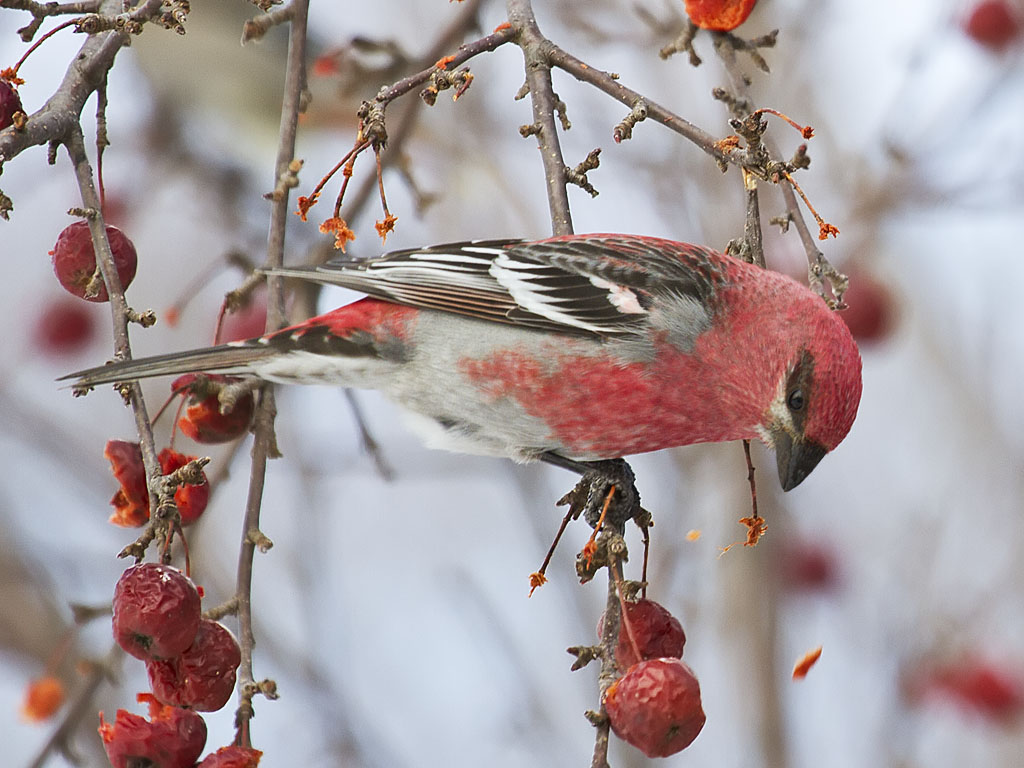
The Pine Grosbeak (Pinicola enucleator) is a large member of the true finch family, Fringillidae, and the only species in the genus Pinicola. Here are some interesting facts about this bird:
Appearance:
– The Pine Grosbeak is a large, plump finch with a thick and stubby bill.
– Adult males are pink overall with two white wingbars and pale gray highlights, while immature males and females are not as brightly colored.
– Females and immature birds are grayish-brown with yellowish underparts and a yellowish or olive-green rump.
Habitat:
– The Pine Grosbeak is found in coniferous woods across Alaska, the western mountains of the United States, Canada, and in subarctic Fennoscandia and across the Palearctic to Siberia.
– It breeds in open spruce, fir, and pine forests, but it drops in elevation and moves into deciduous trees, especially fruiting trees such as mountain-ash or crabapple, in winter.
Behavior:
– The Pine Grosbeak forages in trees and bushes, mainly eating seeds, buds, berries, and insects.
– It tends to be very methodical in feeding, moving about slowly in trees while feeding on buds, seeds, and fruits.
– Except during the nesting season, it often forages in small flocks.
Breeding:
– The female Pine Grosbeak lays 3-4 eggs in a twig nest lined with lichen, moss, and grass, which is built close to the ground.
– The female incubates the eggs for 13-14 days, and the male brings the female food while she is incubating the eggs.
– Both the male and the female feed the chicks, which fledge when they are about two weeks old.
Conservation Status:
– The Pine Grosbeak is evaluated as Least Concern on the IUCN Red List of Threatened Species.
– However, the species is vulnerable to habitat loss and fragmentation, especially in the southern part of its range.
Overall, the Pine Grosbeak is a fascinating bird that is found in coniferous woods across North America and Eurasia.
Roseate Spoonbill
The Roseate Spoonbill (Platalea ajaja) is a gregarious wading bird that belongs to the ibis and spoonbill family, Threskiornithidae. Here are some interesting facts about this bird:
Appearance:
– The Roseate Spoonbill is a large bird with a wingspan of up to 50 inches (127 cm).
– It has a distinctive pink coloration, which is diet-derived and consists of the carotenoid pigment canthaxanthin, like the American flamingo.
– The Roseate Spoonbill has a bald, pale green head, a spoon-shaped bill, and bright red shoulders.
Habitat:
– The Roseate Spoonbill is a resident breeder in both South and North America, and it can be found in mangrove swamps, tidal ponds, saltwater lagoons, and other areas with brackish water.
Behavior:
– The Roseate Spoonbill feeds in shallow water, using its spoon-shaped bill to scoop up small fish, crustaceans, and insects.
– It is a sociable bird that often forages in groups with other wading birds, such as egrets and ibises.
– The Roseate Spoonbill is monogamous, and both the male and female take turns sitting on the eggs and feeding the young.
Breeding:
– The Roseate Spoonbill builds a large, deep, well-constructed nest out of sticks and other materials, which is usually located in thick vegetation above water.
– The female lays two to five brown-speckled white eggs, which hatch after about 24 days.
– The young Roseate Spoonbills are ready to fly in about eight weeks.
Conservation Status:
– The Roseate Spoonbill is evaluated as Least Concern on the IUCN Red List of Threatened Species.
– However, the species was nearly hunted to extinction during the 1800s because its striking pink feathers were popular on women’s hats.
Overall, the Roseate Spoonbill is a fascinating bird that is known for its distinctive pink coloration and spoon-shaped bill. It is found in mangrove swamps, tidal ponds, and other areas with brackish water in both South and North America.
Galah
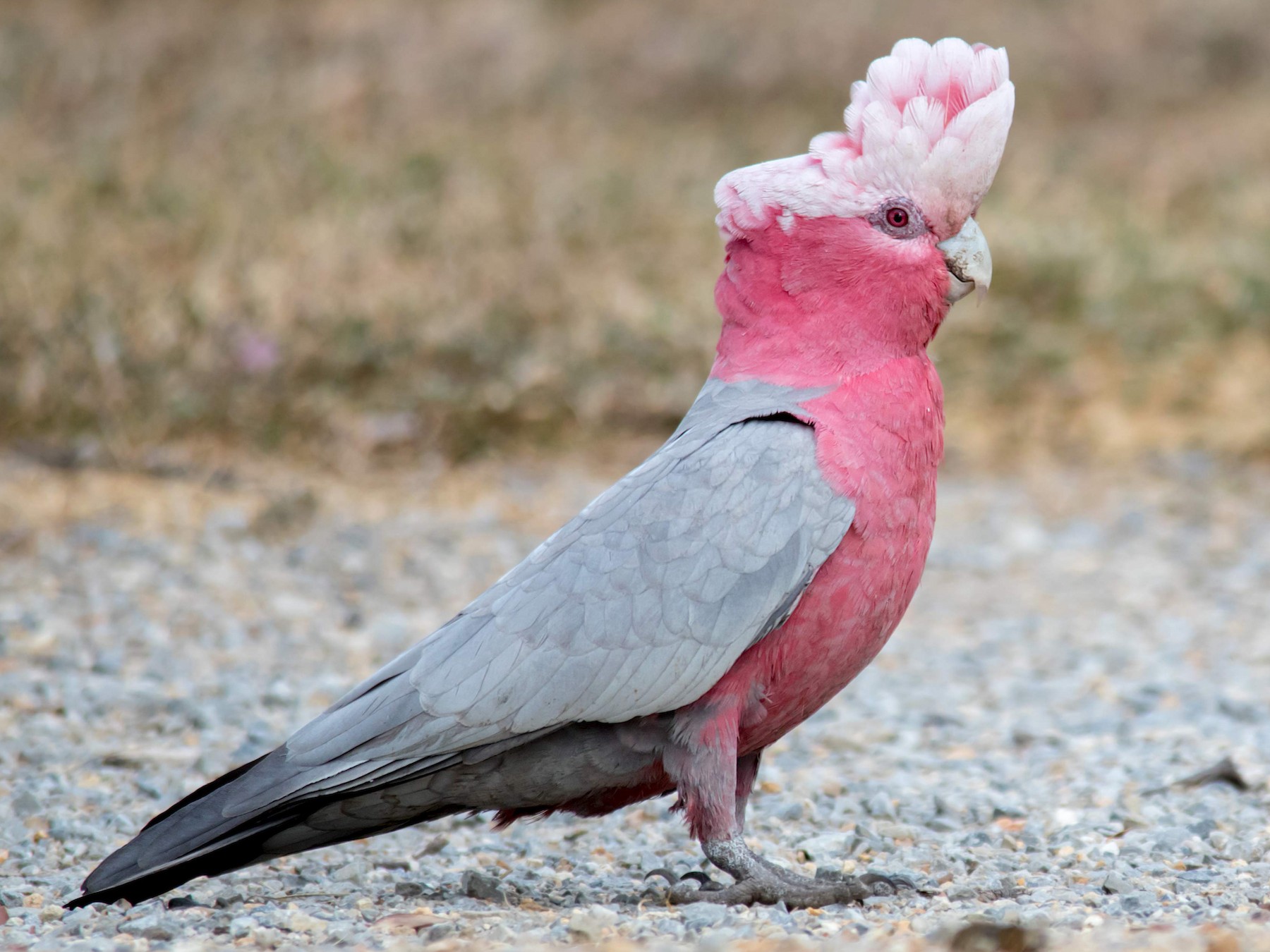
The Galah (Eolophus roseicapilla), also known as the pink and grey cockatoo or rose-breasted cockatoo, is a species of cockatoo that is native to Australia. Here are some interesting facts about this bird:
Appearance:
– The Galah is a medium-sized cockatoo with a distinctive pink and gray plumage.
– Males and females look similar, but males have darker brown eyes, while females have lighter pink eyes.
– The Galah has a short, curved bill, a crest of feathers on its head, and a long tail.
Habitat:
– The Galah is found throughout Australia and is one of the most common cockatoos in the country.
– It is adapted to a wide variety of habitats, including forests, woodlands, savannas, and urban areas.
Behavior:
– The Galah is a social bird that often forms large flocks with other Galahs and cockatoos.
– It is a noisy bird that communicates through a variety of calls, including screeches, whistles, and squawks.
– The Galah is a diurnal bird, which means that it is active during the day and rests at night.
Diet:
– The Galah feeds on a variety of seeds, nuts, fruits, and berries.
– It is known to be an agricultural pest in some areas, as it feeds on cultivated crops.
Breeding:
– The Galah forms permanent pair bonds, and both the male and female take turns incubating the eggs and caring for the young.
– The female lays 2-5 eggs in a tree hollow or similar location, and the eggs hatch after about 25 days.
– The young Galahs fledge when they are about 7-8 weeks old.
Conservation Status:
– The Galah is evaluated as Least Concern on the IUCN Red List of Threatened Species.
– However, the species is sometimes considered a pest because of its habit of feeding on cultivated crops.
Overall, the Galah is a fascinating bird that is known for its distinctive pink and gray plumage and its social behavior. It is found throughout Australia and is one of the most common cockatoos in the country.
Anna’s Hummingbird
Anna’s Hummingbird (Calypte anna) is a North American species of hummingbird that is native to western coastal regions of North America. Here are some interesting facts about this bird:
Appearance:
– Anna’s Hummingbirds are tiny birds that are 3.9 to 4.3 inches (9.9 to 10.9 cm) long with a wingspan of 4.7 inches (12 cm) and a weight range of 0.1 to 0.2 oz (2.8 to 5.7 g).
– They have an iridescent bronze-green back, a pale grey chest and belly, and green flanks.
– The adult male has an iridescent crimson-red, derived from magenta, to a reddish-pink crown and gorget, which can look dull brown or gray without direct sunlight, and a dark, slightly forked tail.
– The female is less colorful, with a green back and greyish underparts.
Habitat:
– Anna’s Hummingbirds are adapted to urban environments and are commonly seen in backyards and parks, and at feeders and flowering plants.
– They are also found in chaparral, coastal scrub, oak savannahs, and riparian woodlands.
Behavior:
– Anna’s Hummingbirds eat flying insects and drink nectar from flowers and hummingbird feeders.
– They are known for their aerial displays during courtship, which involve the male performing a dive over his territory.
– The male’s call is scratchy and metallic and is typically used as the bird perches in trees and shrubs.
Breeding:
– Anna’s Hummingbirds breed throughout the year, with the peak breeding season occurring from December to May.
– The female builds a small cup-shaped nest out of plant fibers and spider silk, which is usually located on a tree branch or other elevated location.
– The female lays two white eggs, which hatch after about 14-19 days.
– The female feeds the young by regurgitating tiny insects, perhaps mixed with nectar.
Conservation Status:
– According to a 2021 estimate, there are 8 million Anna’s Hummingbirds in the western United States and Canada, with the population increasing since 1970.
– As of 2021, the International Union for Conservation of Nature Red List of Threatened Species lists the Anna’s Hummingbird among species of least concern.
Overall, Anna’s Hummingbird is a fascinating bird that is known for its iridescent colors and aerial displays during courtship. It is adapted to urban environments and is commonly seen in backyards and parks, and at feeders and flowering plants.
Major Mitchell’s cockatoo
The Major Mitchell’s cockatoo (Lophochroa leadbeateri), also known as the Leadbeater’s cockatoo or the pink cockatoo, is a medium-sized cockatoo that inhabits arid and semi-arid inland areas of Australia. Here are some interesting facts about this bird:
Appearance:
– The Major Mitchell’s cockatoo is a small, largely white cockatoo with pink on the sides of its head, around its neck, on its underbody, and under its wings.
– It has a magnificent, long white crest with a colorful band of red at the base.
– The male and female look alike, but the male has a slightly larger bill.
Habitat:
– The Major Mitchell’s cockatoo is found in arid and semi-arid inland areas of Australia, including scrublands, woodlands, and savannas.
– It is also found in suburban areas and parks.
Behavior:
– The Major Mitchell’s cockatoo feeds on seeds, nuts, fruits, and insects.
– It is a social bird that often forms flocks with other Major Mitchell’s cockatoos and other cockatoo species.
– The Major Mitchell’s cockatoo is monogamous, and both the male and female take turns incubating the eggs and caring for the young.
Breeding:
– The Major Mitchell’s cockatoo breeds from August to January, with the peak breeding season occurring from September to November.
– The female lays two to five white eggs, which hatch after about 25 days.
– The young Major Mitchell’s cockatoos fledge when they are about 7-8 weeks old.
Conservation Status:
– The Major Mitchell’s cockatoo is evaluated as Least Concern on the IUCN Red List of Threatened Species.
– However, the species is vulnerable to habitat loss and fragmentation, especially in the southern part of its range.
Overall, the Major Mitchell’s cockatoo is a fascinating bird that is known for its distinctive pink and white plumage and its magnificent crest. It is found in arid and semi-arid inland areas of Australia and is a social bird that often forms flocks with other Major Mitchell’s cockatoos and other cockatoo species.
Hoopoe
The Hoopoe (Upupa epops) is a colorful bird found across Africa, Asia, and Europe, notable for its distinctive “crown” of feathers. Here are some interesting facts about this bird:
Appearance:
– Hoopoes are small to medium-sized birds that are about the size of a mistle thrush.
– They have a pinkish-brown body, striking black and white wings, a long black bill, and a long, thin tapering bill that is black with a fawn base.
– The Hoopoe has a distinctive cinnamon-colored body with black and white wings, a tall erectile crest, a broad white band across a black tail, and a long narrow downcurved bill.
Habitat:
– Hoopoes are found in a variety of habitats, including woodland, heathland, farmland, orchards, and grassy lawns.
– They are native to Europe, Asia, and the northern half of Africa.
Behavior:
– Hoopoes feed on the ground, probing with their long bill for insects, grubs, and other small invertebrates.
– They are known for their distinctive “hoopoopoo” call, which is used for communication and territorial defense.
– Hoopoes are monogamous and form long-term pair bonds.
Cultural Significance:
– Hoopoes have made a cultural impact over much of their range. They were considered sacred in Ancient Egypt and were “depicted on the walls of tombs and temples”.
– In Jewish tradition, a Hoopoe led King Solomon to meet the Queen of Sheba, which may help explain why in 2008, the Hoopoe won a popular vote to become the national bird of Israel.
– Hoopoes were seen as a symbol of virtue in Persia, and a Hoopoe was a leader of the birds in the Persian book of poems The Conference of the Birds.
Conservation Status:
– The Hoopoe is evaluated as Least Concern on the IUCN Red List of Threatened Species.
– However, the species is vulnerable to habitat loss and fragmentation, especially in the southern part of its range.
Read more : Cardinals Big Bird Bath Users
Overall, the Hoopoe is a fascinating bird that is known for its distinctive appearance and cultural significance. It is found in a variety of habitats across Africa, Asia, and Europe and feeds on the ground, probing with its long bill for insects and other small invertebrates.
Pink-headed Warbler
The Pink-headed Warbler (Cardellina versicolor) is a small passerine bird found in the southwestern highlands of Guatemala and the central and southeastern highlands of the Mexican state of Chiapas. Here are some interesting facts about this bird:
Appearance:
– The Pink-headed Warbler is a small bird that measures 12.5–13.5 cm (4.9–5.3 in) in length and weighs 10 g (0.35 oz).
– Both sexes have a similar plumage, though females are, on average, slightly duller overall.
– The adult has dark red upperparts, a silvery-pink chest, and pinkish-red underparts.
– Its head is silvery-pink, with a reddish forehead, dusky lores, and dark brown irises.
– Its bill is blackish, sometimes showing some horn color on the lower mandible, and its legs are flesh-colored.
Habitat:
– The Pink-headed Warbler is a fairly common to common resident of humid to semi-humid pine-oak, pine-evergreen, and evergreen forest and edge, at altitudes ranging from 1,800–3,500 m (5,900–11,500 ft) above sea level.
– It is locally common above 2300 m (7500 ft) in Guatemala, where it lives in cloud forests, pine-oak forests, humid coniferous forests, and adjacent brushy areas.
Behavior:
– The Pink-headed Warbler is an insectivore, gleaning insects and other invertebrates from vegetation, primarily in the canopy.
– It is resident in its range and does not migrate.
– The Pink-headed Warbler is known for its distinctive call, which is a series of high-pitched, descending notes.
Conservation Status:
– The Pink-headed Warbler is evaluated as Least Concern on the IUCN Red List of Threatened Species.
– However, the species is vulnerable to habitat loss and fragmentation, especially in the southern part of its range.
Overall, the Pink-headed Warbler is a fascinating bird that is known for its distinctive pink and red plumage and its insectivorous diet. It is found in the highlands of Guatemala and the southeastern highlands of the Mexican state of Chiapas, and it is a fairly common to common resident of humid to semi-humid pine-oak, pine-evergreen, and evergreen forest and edge.
Brownc-apped Rosy-Finch
The Brown-capped Rosy-Finch (Leucosticte australis) is a medium-sized finch that is endemic to North America. Here are some interesting facts about this bird:
Appearance:
– The Brown-capped Rosy-Finch is a small, compact songbird with a conical bill, relatively short tail, and rather long wings.
– Adults are brown on the head, back, and breast with pink on the belly, rump, and wings.
– The forehead is black, and they have short black legs and a long forked tail.
– They have an indistinct grayish-brown crown.
Habitat:
– The Brown-capped Rosy-Finch breeds almost entirely in Colorado, in high alpine areas near remote glaciers and snowy meadows where they feed on seeds and insects along the.
– They are also found in the high peaks of the Rockies from Wyoming south to New Mexico.
Behavior:
– The Brown-capped Rosy-Finch feeds on seeds and insects.
– They are known for their distinctive pink highlights in the wings, tail, belly, and indistinct grayish-brown crown.
– They breed at very high elevations and descend to lower elevations in the winter.
Conservation Status:
– The Brown-capped Rosy-Finch is evaluated as Least Concern on the IUCN Red List of Threatened Species.
– However, the species is vulnerable to habitat loss and fragmentation, especially in the southern part of its range.
Overall, the Brown-capped Rosy-Finch is a fascinating bird that is known for its distinctive pink and brown plumage and its high-altitude habitat. It is found in high alpine areas near remote glaciers and snowy meadows in Colorado and the high peaks of the Rockies from Wyoming south to New Mexico.
Black Rosy-Finch
The Black Rosy-Finch (Leucosticte atrata) is a medium-sized finch that is endemic to North America, found in alpine areas above treeline in the western United States. Here are some interesting facts about this bird:
Appearance:
– The Black Rosy-Finch is a medium-sized, slightly stocky finch that measures about 14 to 16 cm in length and weighs 22 to 32 grams.
– Breeding birds are blackish overall with pink highlights on the wings and belly, while non-breeding birds are brownish-black overall.
– They have a gray cap and a notched tail, and their bill is medium-sized for eating seeds.
Habitat:
– The Black Rosy-Finch is found in alpine areas above treeline in the mountains of the western United States.
– They reside in open areas near cliffs and around snowmelt.
Behavior:
– The Black Rosy-Finch feeds on seeds and insects.
– They are known for their distinctive pink highlights on the wings and belly.
– They forage in large flocks often with other rosy-finches.
Conservation Status:
– The Black Rosy-Finch is evaluated as Least Concern on the IUCN Red List of Threatened Species.
– However, its mountaintop habitats are especially vulnerable to the effects of climate change.
Overall, the Black Rosy-Finch is a fascinating bird that is known for its distinctive pink highlights on the wings and belly and its alpine habitat. It is found in alpine areas above treeline in the mountains of the western United States and feeds on seeds and insects.
FAQS
1. What are some of the most common pink birds in North America?
Some of the most common pink birds in North America include the Roseate Spoonbill, American Flamingo, Anna’s Hummingbird, Scarlet Ibis, Pink Cockatoo, Bourke’s Parakeet, Pine Grosbeak, and Pink-headed Fruit Dove.
2. What is the habitat of the Brown-capped Rosy-Finch?
The Brown-capped Rosy-Finch is found in alpine areas above treeline in the western United States.
3. What is the habitat of the Pink-headed Warbler?
The Pink-headed Warbler is a fairly common to common resident of humid to semi-humid pine-oak, pine-evergreen, and evergreen forest and edge, at altitudes ranging from 1,800–3,500 m (5,900–11,500 ft) above sea level.
4. How do pink birds get their color?
Pink birds get their color from a variety of sources, including natural pigments in their feathers, light refraction, and diet. Wading birds like flamingos and ibises acquire their coloration from the carotene found in shrimp.
5. What is the conservation status of the Black Rosy-Finch?
The Black Rosy-Finch is evaluated as Least Concern on the IUCN Red List of Threatened Species, but its mountaintop habitats are especially vulnerable to the effects of climate change.
6. What is the cultural significance of the Hoopoe?
The Hoopoe has made a cultural impact over much of its range. It was considered sacred in Ancient Egypt and was “depicted on the walls of tombs and temples.” In Jewish tradition, a Hoopoe led King Solomon to meet the Queen of Sheba, which may help explain why in 2008, the Hoopoe won a popular vote to become the national bird of Israel.
7. What is the behavior of the Pink-headed Fruit Dove?
The Pink-headed Fruit Dove feeds on fruit and insects and is a shy and discreet species. It has purple-pink heads, throats, and necks, green upperparts, and gray underparts with yellow undertail coverts. This fruit dove also features orange irises, green bills, and fuchsia feet.
8. What is the appearance of the Pink Robin?
The Pink Robin is a bird that’s often overlooked, even with its bright pink breast. They’re small, chunky birds that are quieter than other robins. Male Pink Robins have black heads and throats and have brownish-black upper parts. Additionally, they have a small white spot just above their bill. Females also have a spot above their bill, which is buff instead of white. Males have a pink wash on their breast that expands to the underbelly. Female Pink Robins have a pinkish tint, are olive-brown above, and have…
Source: https://petstutorial.com
Category: Birds










